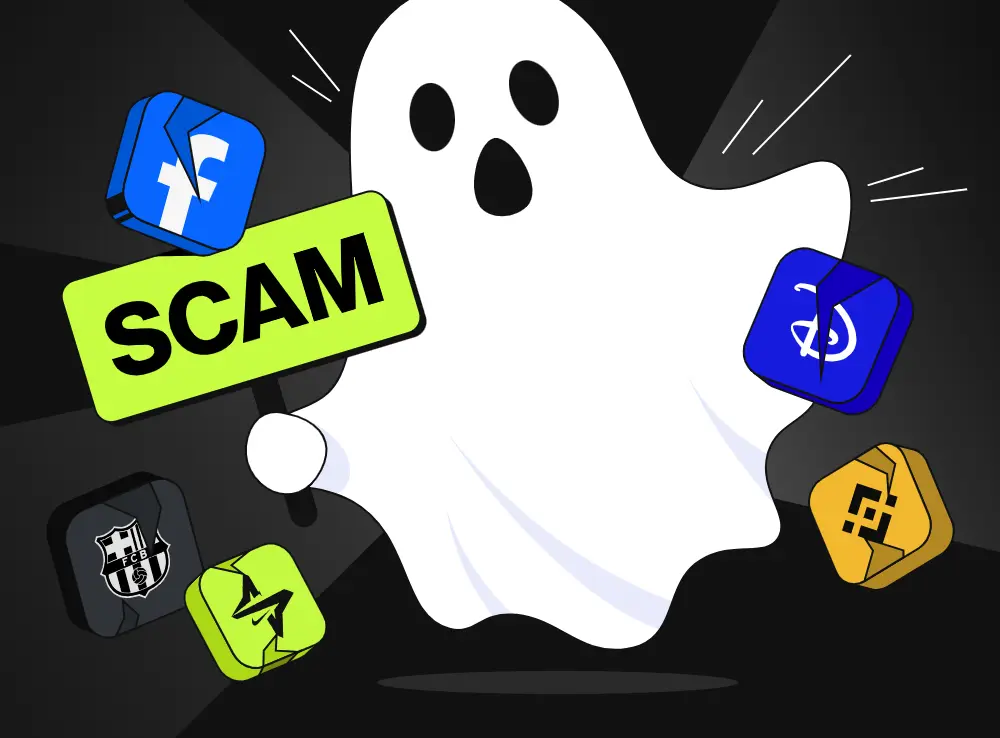Social Media Nightmares That Haunted October 2025
Social Media Nightmares That Haunted October 2025
Online attacks targeting social media accounts show no signs of slowing down. Every week brings new reports of high-profile hacks, impersonations, and elaborate scams that compromise both individual and corporate accounts. What once seemed like rare incidents are now regular occurrences that threaten brands of all sizes.
October 2025 proved particularly brutal for social media security. From cryptocurrency exchanges to entertainment giants, no one was safe from attackers who exploited vulnerabilities and social engineering tactics to breach accounts with millions of followers.
In this blog post, we'll examine all the major social media breaches that happened this month, analyze why businesses should care about this growing threat, and explore the specific steps you can take to protect your accounts from similar attacks.
What High Profiles Happened In October 2025?
This month saw a disturbing number of high-profile account breaches across multiple platforms. Major brands, athletes, and entertainment companies all experienced unauthorized access that led to financial losses, reputation damage, and customer confusion. Each incident revealed different attack vectors and highlighted the diverse tactics cybercriminals use to compromise accounts.
Here’s a brief overview of each one of them:
Binance X Account Hack
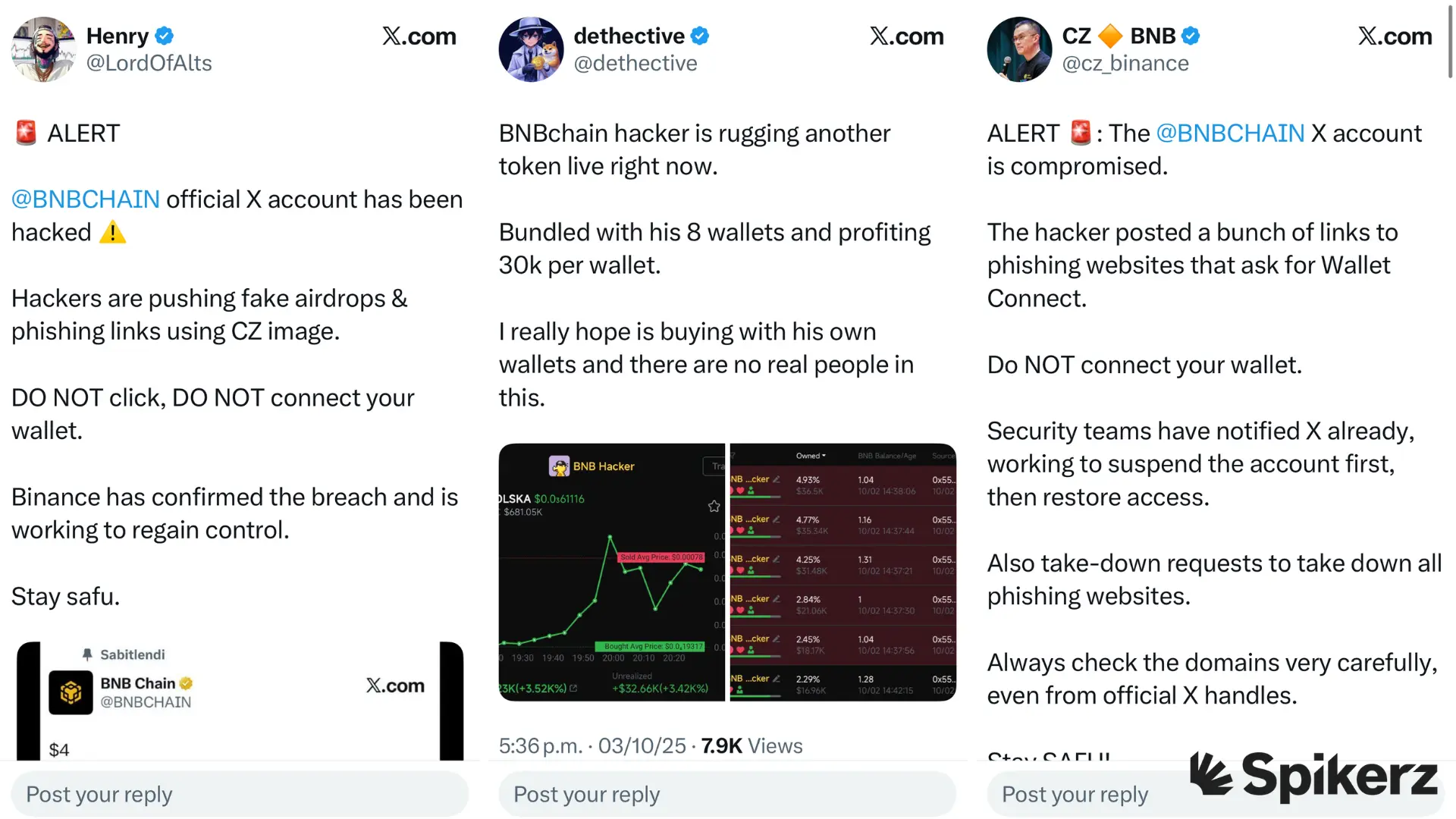
On October 1, Binance's official English X account was hacked and briefly used to spread fraudulent "airdrop" links. The account promoted phishing scams disguised as WalletConnect prompts, tricking users into connecting their wallets and risking stolen funds.
Former Binance CEO Changpeng Zhao (CZ) responded quickly from his verified account, warning users not to click on any links from the hacked handle. He confirmed the posts contained phishing material and said Binance had contacted X to suspend the account and filed takedown requests for the phishing domains.
Thankfully, losses amounted to only about $13,000. CZ assured victims that they would be reimbursed and noted that Binance's security teams are tracking the attacker, who may be identifiable through KYC.
Matt Hardy's Instagram Account Hack
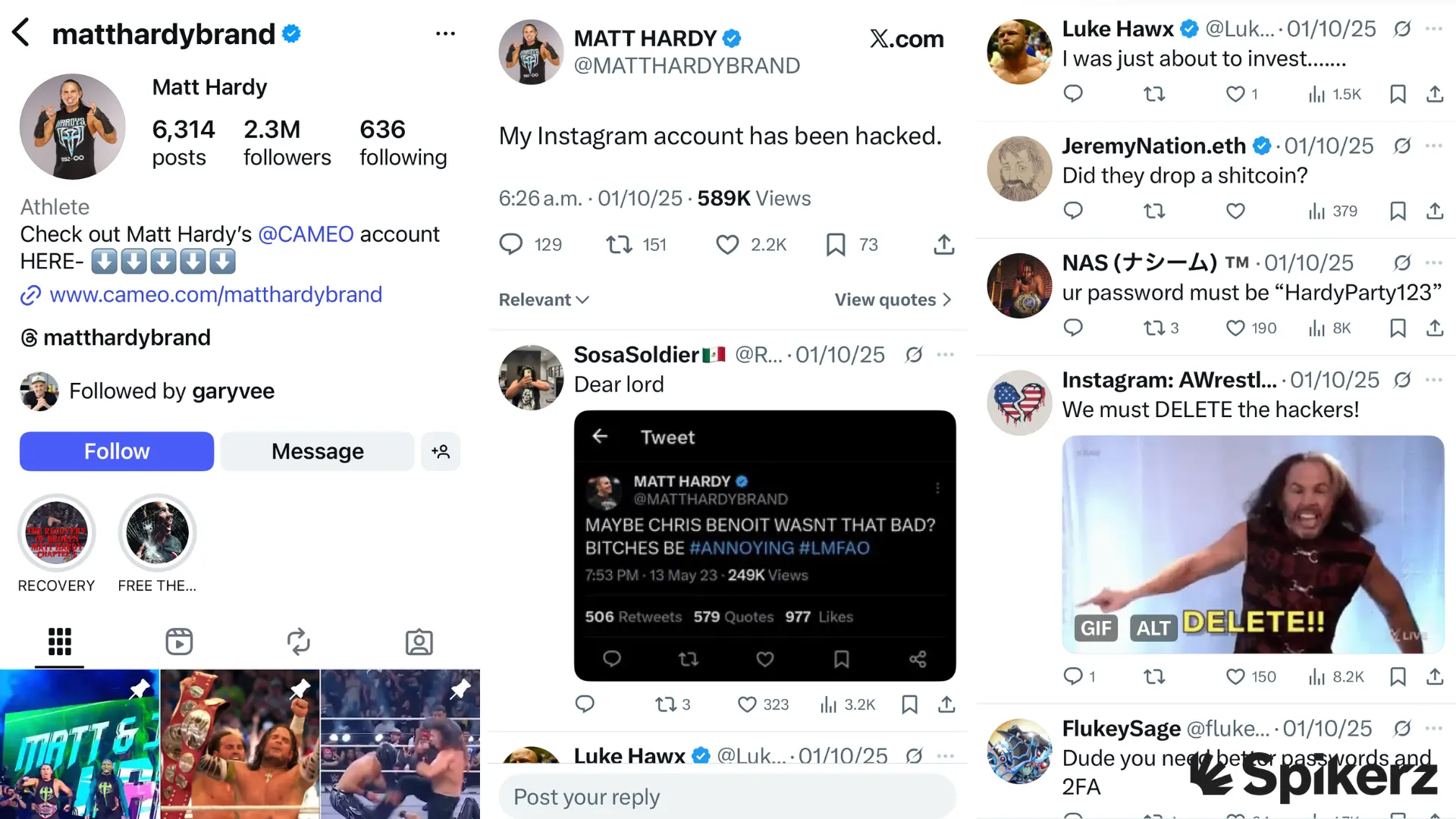
On October 1, 2025, Matt Hardy's Instagram account was hacked. Fans noticed something was off when his feed suddenly featured a post and story promoting a cryptocurrency token.
While wrestlers often promote brands, the tone of this post felt weird. The post promised followers "millions of free WLFI tokens," mentioned exclusive NFTs, and included multiple links and emojis.
Hardy quickly confirmed the situation on his X account, posting a straightforward message: "My Instagram account has been hacked." Later that day, he shared an update explaining that the hacker had been "DELETED." He thanked fans for their patience, noted that he was able to address the issue early with the help of a specialist, and clarified that his account had strong passwords and two-factor authentication in place. The issue, he said, came from a "fluke backdoor," but fortunately, little was compromised.
The good news is, there were no reports of fans falling for the scam. It likely helped that this wasn't Hardy's first experience with hacking. Back in 2023, his X account was compromised and hackers posted disturbing messages about Chris Benoit and others. This time, though, Hardy acted fast and managed to minimize the damage before it could spread.
Max Ehrich's Instagram Account Hack
On October 2, 2025, actor and singer Max Ehrich, known for being Demi Lovato's ex-boyfriend, had his Instagram account hacked. The breach led to explicit photos of him being uploaded online, quickly spreading before they were taken down.
The leaked images caused an uproar among fans, who flooded social media with shock, outrage, and concern. Many called out the hackers for invading Ehrich's privacy, while others expressed sympathy and support for the actor as he faced the incident publicly.
Even after the posts were deleted, confusion was still there. Some followers were still trying to make sense of what happened and whether Ehrich had regained control of his account. He nor his team ever addressed the situation and a response was never given.
Disney's Instagram Account Hack

On October 1, 2025, Disney's official accounts were hacked by an unknown group that led to a wave of fake news that spread across social media. The attackers used Disney's verified pages to promote a non-existent cryptocurrency called "Disney Solana," fooling some users into thinking that it was an official launch.
Posts featuring the fake coin's logo and buying instructions appeared on multiple Disney accounts before they were quickly deleted. But the damage was already done. Fans flooded Reddit and X with screenshots and theories about who was behind the attack. One Reddit user claimed the fake coin briefly hit a $60,000 market cap before crashing to $7,000, costing unsuspecting fans thousands of dollars.
Eyewitness accounts and social media reactions show how quickly trust can be broken when a major brand's accounts are compromised. Although Disney removed all hacked posts and stories shortly after they appeared, the company didn't officially confirm the extent of the breach or how it happened.
Jadon Sancho's TikTok Account Hack
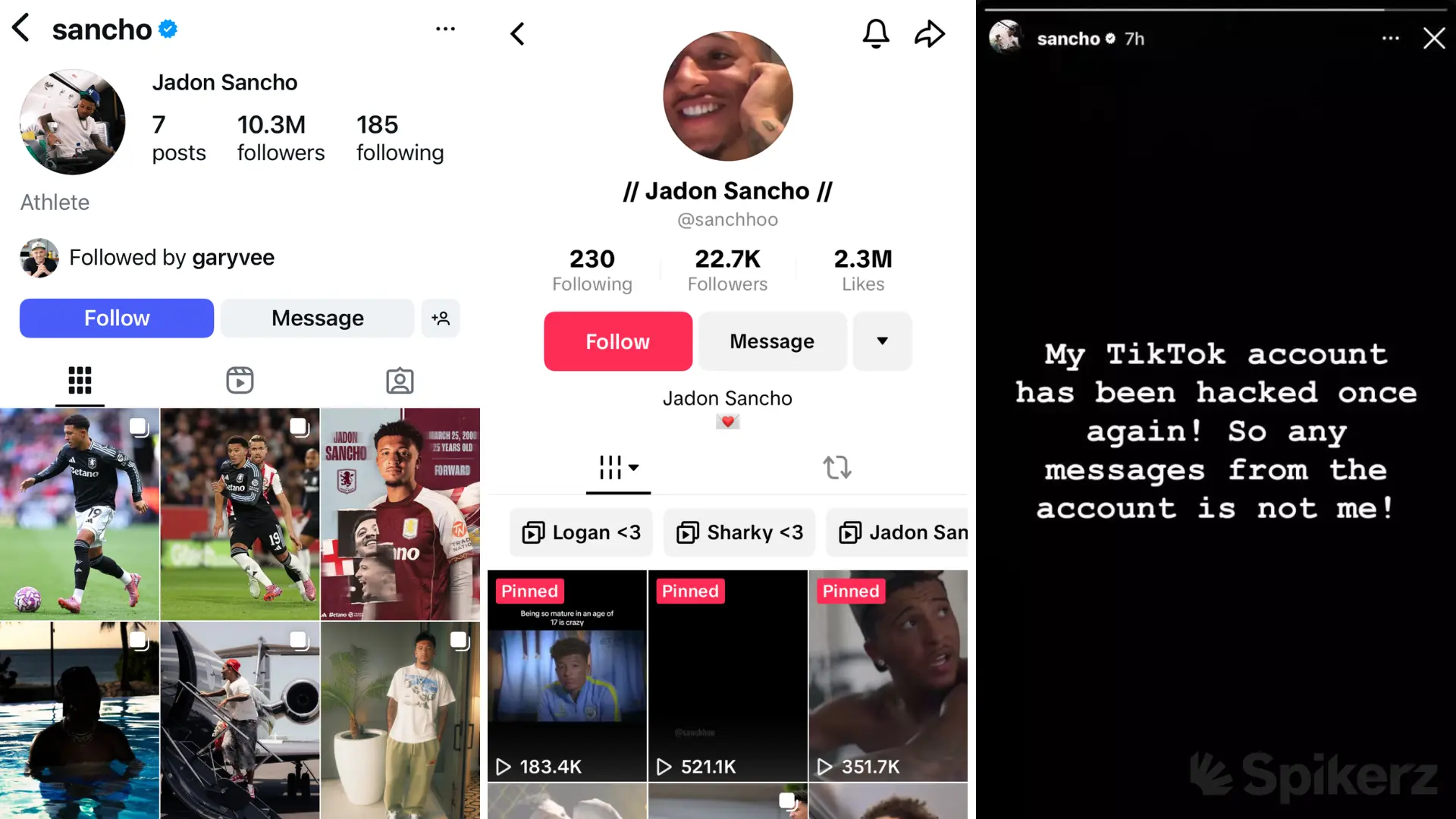
On October 6, 2025, Manchester United's Jadon Sancho confirmed that his TikTok account had been hacked again. He announced what happened shortly after United's 3-0 defeat to Liverpool on Saturday.
Sancho posted a brief statement on his Instagram story, saying, "My TikTok account has been hacked once again! So any messages from the account is not me!"
No further comments followed the post, but the hack created confusion among fans and raised some concerns about the security of his social media presence.
FC Barcelona's Instagram Account Hack

On October 7, 2025, FC Barcelona's official Instagram account was hacked and used to promote a fake crypto project on the memecoin platform Pump Fun. Hackers posted that the club was "building something massive on Solana" and urged followers to join in, claiming "we're going to the moon." They even shared the token's address across two separate posts.
None of it was real though. There was no official announcement from the club's website, and the posts were clearly part of a scam. Still, with over 144 million followers, the posts gained traction quickly. One of them racked up 169,000 views, more than 1,600 comments, and 1,400 reposts before it was eventually removed.
The fake $FCB token launched shortly after, hitting a market cap of $3 million within hours before crashing by more than 98% to about $50,000. Trading volume reached $3.5 million in 24 hours, and the scammer behind the account made roughly $26,000 in creator rewards before the token collapsed.
After regaining control, FC Barcelona deleted the fraudulent posts and restored access to their Instagram account. Still, the incident damaged the club's credibility online and highlighted how anyone, even high profile accounts can become victims too.
Why Should You Even Care About All Of This?
Businesses should care about the massive rise in account hacks and online attacks because the risks have drastically increased. If you're managing brand accounts with thousands or millions of followers, a single breach can destroy years of carefully built trust in minutes.
This is supported by many recent reports. For example, the 2024 Verizon Data Breach Investigations Report found that attacks exploiting software vulnerabilities increased by 180% compared to the previous year. Many of these incidents were driven by ransomware and extortion groups targeting weak points in systems. For any businesses, one breach can expose sensitive data, disrupt operations, and severely damage customer trust, which can take years to rebuild.
Phishing attacks are also getting harder to detect. According to KnowBe4's 2025 Phishing Threat Trends Report, over 76% of phishing campaigns in 2024 included polymorphic features that help them bypass detection. Even more concerning, 74% of all phishing emails showed some use of AI, and that number rose to 91% for those with polymorphic elements. This means cybercriminals are now using AI to send highly targeted and convincing messages that are difficult to identify.
If businesses don't take cybersecurity seriously, they could easily be the next target. Strengthening defenses, training employees, and keeping systems updated are key to stay protected.
How Can Brands Protect Their Social Media Presence?
The key to protecting your social media presence is to reduce the attack surface, add as many layers of protection as possible, and to apply the principle of least privilege. Reducing the attack surface limits the areas attackers can exploit, every additional security measure makes it exponentially harder for attackers to gain unauthorized access, and limiting permissions reduces the potential damage if a breach does occur.
That said, here are the most important things you should do to protect your accounts:
1) Use Strong, Unique Passwords

If your business manages multiple social media accounts, it's a must for you to use strong passwords for each account. Reusing the same one or relying on weak ones creates a single point of failure hackers can easily exploit.
If one account is compromised, then every other account that shares that password could also be exposed. Strong, unique passwords help prevent unauthorized access and keep your content and data safe. They are also important for compliance since many industries require businesses to enforce strict password policies. If you fail to follow these rules you could face penalties.
Another key reason to use strong passwords is protection against brute force attacks, where hackers use software to quickly guess password combinations until they find the right one. If you use simple passwords these can be done fairly quickly.
For all of these reasons you must use complex, randomly generated passwords. They should be at least 14 characters long, though 20 is much better. You should mix uppercase and lowercase letters, numbers, and symbols. Avoid dictionary words, personal details, or common patterns since hackers target those first.
2) Enable 2FA For Teams
Two-factor authentication, or 2FA, is one of the simplest and most effective ways to secure accounts. It requires two different verification factors, usually a code from an authenticator app or device and an email and password. Research by CISA and Microsoft found that enabling multi-factor authentication prevents 99% of automated attacks.
2FA for teams takes this concept further. Instead of sending codes to one person's phone, access is managed centrally in a dashboard so multiple team members can securely get access to codes. As an Admin, you decide who gets access. If someone leaves or changes roles, their access can quickly be revoked without disrupting the rest of the team.
For marketing teams managing social media accounts like X, this is especially important. Shared logins are often the weakest point, especially when passwords are reused or too simple. However, with a team-based 2FA, attackers can't get in even if a password is compromised.
3) Audit Your Team Members

Every business must keep track of who has access to their social media accounts. When they ignore it, it leaves their brand exposed to serious risks that are easy to avoid with regular access review.
For instance, if a former employee still has access to your accounts, they could easily cause damage. They might delete posts, change settings, or even remove the account completely. Someone with old access could also post unauthorized content that hurts your brand's reputation.
Even current team members can cause problems if they have more access than they need. A junior marketer with admin rights, for example, could accidentally delete important content or change settings that affect your campaigns.
There's also the issue of data privacy. If people who no longer work with you still have access to customer information, your business could face compliance risks under laws like CCPA or GDPR, leading to expensive legal trouble that can be completely preventable.
To stay safe, take time to review each person's role and access level. Ask yourself if their permissions match what they actually need to do their job. Do they have more control than necessary? Make sure there's a process in place to revoke access when someone leaves your team. Also check for overlap. Are there multiple people with the same permissions doing similar tasks?
4) Enable Account Monitoring
Social media platforms can handle some monitoring for you, or you can do it manually. But if you're running a business, especially with multiple accounts, it's much better to use a third-party tool that centralizes everything and strengthens your defenses.
Social media security tools are exactly built for that. They continuously scan accounts for threats, catching unusual login attempts, suspicious messages, or sudden spikes in activity before they turn into real problems.
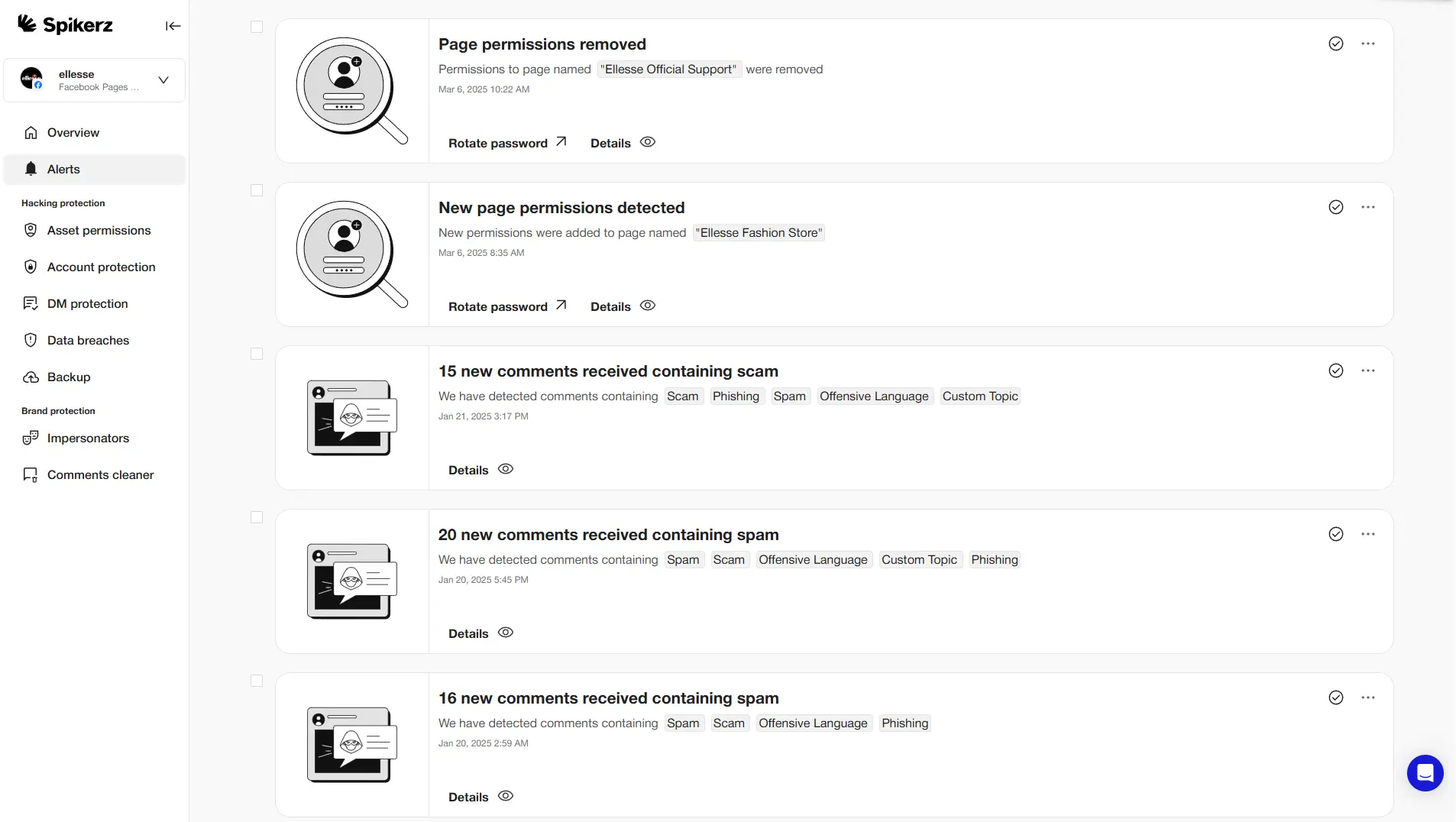
For example, Spikerz is one of these specialized tools. It protects your accounts from phishing, bots, and other social engineering attacks by monitoring login patterns, unrecognized access, permission changes, and breaches in real time.
It can automatically remove intruders, reset compromised passwords, and send instant alerts during a breach. It provides automated backups for quick recovery, filters out spam and offensive content, and ensures posts comply with platform policies so you avoid limitations or shadowbans.
5) Use Antivirus Software
Antivirus software provides essential protection for organizational devices against malware like keyloggers, compromised applications, and other local security risks that increase your attack surface.
Cybercriminals often trick users into visiting spoofed domains or downloading applications that steal your personal information. What's worse is that these threats seem legitimate, making them hard to detect without help.
Antivirus protection adds another layer of defense that reduces the chances of a successful attack. Browser extensions and local file monitoring systems play a big role here, scanning for suspicious activity patterns during web browsing and analyzing downloaded files for hidden malicious code.
6) Train Your Employees To Recognize Phishing Attacks
Employees are often the weakest link in any security framework. This isn't because they intentionally undermine security but because human factors like fatigue, distraction, or lack of awareness make them vulnerable to mistakes.
Most employees struggle to recognize phishing attempts, which still are one of the most common and effective attack methods. That's why proper training is an essential layer of defense.
But training shouldn't be a one-time event. Regular sessions and ongoing testing keep employees sharp and aware of new tactics attackers use. Live phishing tests can also show you where weak spots are, allowing you to provide targeted support and reinforce security where it's needed most.
Conclusion
October 2025 delivered a harsh reminder that no account is safe from determined attackers. Each incident followed a similar pattern: attackers gained access, exploited trust, and caused damage before victims could respond.
All the data tells a clear story. Attacks are getting more sophisticated, more frequent, and harder to detect. AI-powered phishing campaigns bypass traditional defenses while vulnerabilities in systems create entry points that attackers ruthlessly exploit. Your business can't afford to wait until after a breach to take security seriously.
Start with the basics: strong passwords, team-based 2FA, regular access audits, and continuous monitoring. Tools like Spikerz provide the specialized protection social media accounts need. Train your employees to recognize threats and establish clear processes for responding to incidents. Every layer of security you add makes it harder for attackers to succeed. Your brand's reputation depends on the actions you take right now.

